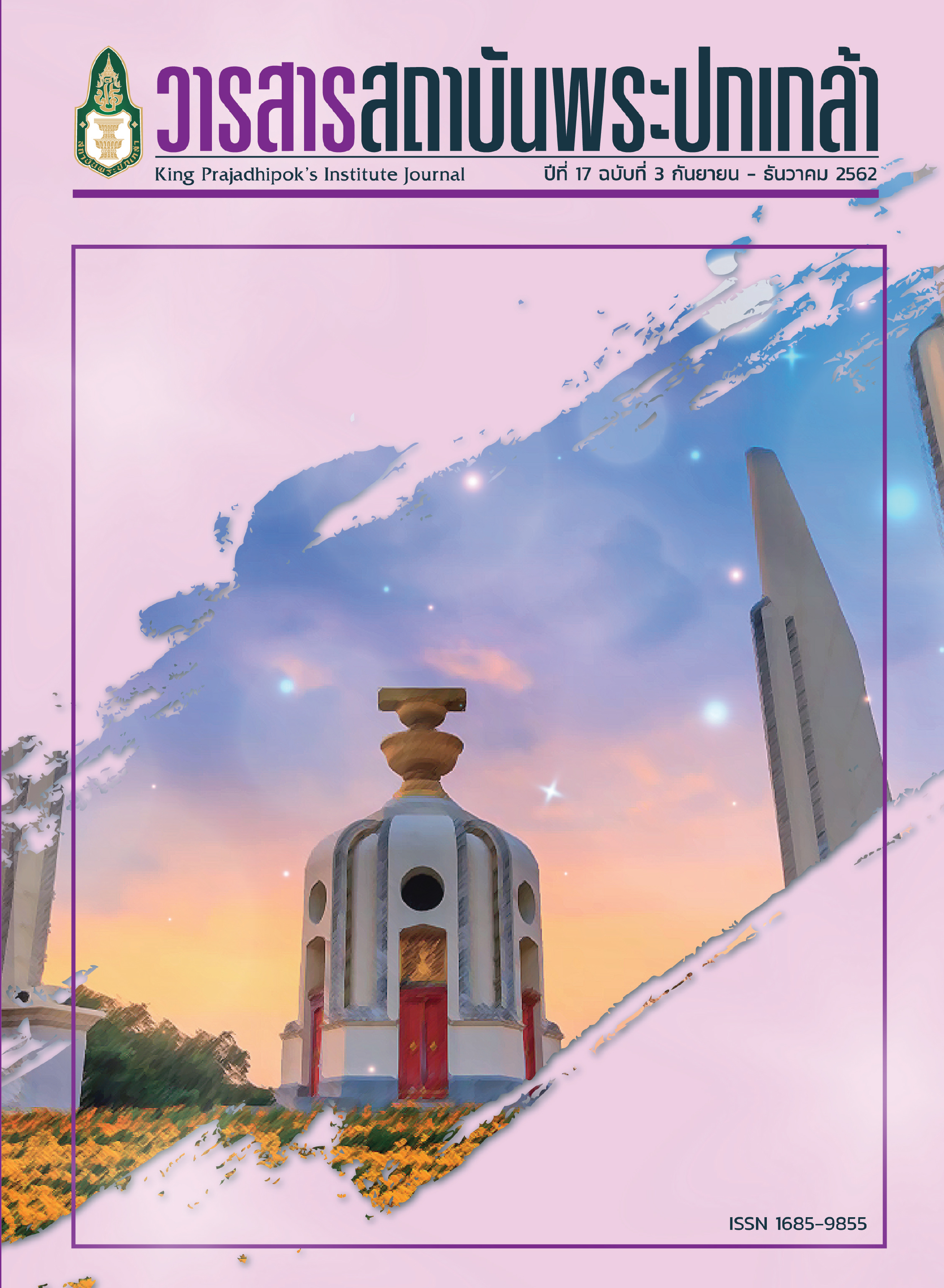An Analysis of Thai Public Administration: From Past to Present
Main Article Content
Abstract
The purposes of this academic article were to, firstly, review important paradigms of public administration, and secondly, review the development of Thailand’s public administration system.
The study identified four important paradigms of public administration: (1) traditional public administration, (2) new public management (3) new public service and (4) new public governance paradigm.
Review of the development of Thailand’s public administration system revealed five bureaucratic reform periods and explored the reasons that prompted each reform. The five periods are: (1) reform of the Thai bureaucracy during the reign of
King Rama III (1448 - 1470); (2) reform of the Thai bureaucracy during the reign of King Chulalongkorn (1868 - 1910); (3) reform of the Thai bureaucracy in 1933; (4) reform of the Thai bureaucracy in 2002; and (5) guidelines for the reform of the
Thai bureaucratic system according to the Constitution of the Kingdom of Thailand 2017.
Article Details
@ 2020 King Prajadhipok's Institute The Government Complex Commemorating All Right Reserved.
References
คณะกรรมการผู้สูงอายุแห่งชาติ กองทุนผู้สูงอายุ. (2560). รายงานสถานการณ์ผู้สูงอายุไทย พ.ศ. 2559. กรุงเทพฯ: อมรินทร์พริ้นติ้งแอนด์พับลิชชิ่ง.
คณะกรรมการผู้สูงอายุแห่งชาติ กองทุนผู้สูงอายุ. (2562). รายงานสถานการณ์ผู้สูงอายุไทย พ.ศ. 2561. นครปฐม: พริ้นเทอรี่.
ณัฐฐา วินิจนัยภาค. (2558). ทิศทางของรัฐประศาสนศาสตร์. ใน สุจิตรา บุณยรัตพันธุ์ (บรรณาธิการ), รัฐประศาสนศาสตร์ในประเทศไทย การเปลี่ยนแปลง การพัฒนา และทิศทาง : เนื่องในโอกาสครบรอบ 60 ปี แห่งการสถาปนาคณะรัฐประศาสนศาสตร์ สถาบันบัณฑิตพัฒนบริหารศาสตร์. กรุงเทพฯ: คณะรัฐประศาสนศาสตร์ สถาบันบัณฑิตพัฒนบริหารศาสตร์.
ทินพันธุ์ นาคะตะ. (2558). กระบวนทัศน์รัฐประศาสนศาสตร์ไทย อดีต ปัจจุบัน อนาคต: จากมุมมองของนักรัฐศาสตร์. ใน สุจิตรา บุณยรัตพันธุ์ (บรรณาธิการ), รัฐประศาสนศาสตร์ในประเทศไทยการเปลี่ยนแปลง การพัฒนา และทิศทาง : เนื่องในโอกาสครบรอบ 60 ปี แห่งการสถาปนาคณะรัฐประศาสนศาสตร์ สถาบันบัณฑิตพัฒนบริหารศาสตร์. กรุงเทพฯ: คณะรัฐประศาสนศาสตร์ สถาบันบัณฑิตพัฒนบริหารศาสตร์.
ทิพวรรณ หล่อสุวรรณรัตน์. (2549). รัฐบาลอิเล็กทรอนิกส์ e–Government. พิมพ์ครั้งทีี่ 2. กรุงเทพฯ: รัตนไตร.
ทิพวรรณ หล่อสุวรรณรัตน์. (2561). บทที่ 14: มุมมองต่างกระบวนทัศน์ในบริบทของไทย. ใน ทฤษฎีองค์การ: มุมมองต่างกระบวนทัศน์ (Organization Theory: Multi-Paradigm Perspectives). กรุงเทพฯ: แซทโฟร์ พริ้นติ้ง.
ทวีศักดิ์ สูทกวาทิน. (2545). การปฏิรูประบบราชการไทย: การเปลี่ยนแปลงเชิงโครงสร้าง. สืบค้นจาก http://library1.nida.ac.th/jourfull1/taweesak1/taweesak_bureaucracy1.pdf
ไทยพับลิก้า. (2015). คนป่วยแห่งเอเชีย: The Sick Man of Asia เป็นโรคร้ายเรื้อรัง หรือ แค่เป็นหวัด. สืบค้นจาก https://thaipublica.org/2015/04/banyong-pongpanich_48/
นิสดาร์ก เวชยานนท์. (2558). กระบวนทัศน์รัฐประศาสนศาสตร์ไทย อดีต ปัจจุบัน อนาคต: จากมุมมองของนักรัฐประศาสนศาสตร์. ใน สุจิตรา บุณยรัตพันธุ์ (บรรณาธิการ), รัฐประศาสนศาสตร์ในประเทศไทย การเปลี่ยนแปลง การพัฒนา และทิศทาง : เนื่องในโอกาสครบรอบ 60 ปี แห่งการสถาปนาคณะรัฐประศาสนศาสตร์ สถาบันบัณฑิตพัฒนบริหารศาสตร์. กรุงเทพฯ: คณะรัฐประศาสนศาสตร์ สถาบันบัณฑิตพัฒนบริหารศาสตร์.
บุญเกียรติ การะเวกพันธุ์ และคณะ (2559). การปฏิรูประบบราชการ. สืบค้นจาก http://wiki.kpi.ac.th/index.php?title==การปฏิรูประบบราชการ
ปกรณ์ ศิริประกอบ. (2560). 3 พาราไดม์ทางรัฐประศาสนศาสตร์: แนวคิด ทฤษฎี และการนำไปปฏิบัติจริง. กรุงเทพฯ: โรงพิมพ์แห่งจุฬาลงกรณ์มหาวิทยาลัย.
ประสบโชค ประมงกิจ. (2549). คู่มือเทคนิคและวิธีการบริหารจัดการสมัยใหม่ตามแนวทางการบริหากิจการบ้านเมืองที่ดี: รูปแบบรัฐบาลอิเล็กทรอนิกส์. พิมพ์ครั้งที่ 2. กรงเทพฯ: สหมิตรพริ้นติ้ง.
พิทยา บวรวัฒนา. (2558). รัฐประศาสนศาสตร์: ทฤษฎีและแนวการศึกษา (ค.ศ. 1887-ค.ศ. 1990). กรุงเทพฯ: คณะรัฐศาสตร์ จุฬาลงกรณ์มหาวิทยาลัย.
ไพโรจน์ ภัทรนรากุล. (2558). รัฐประศาสนศาสตร์ในประเทศไทย: วิวัฒนาการ การเปลี่ยนแปลง และความท้าทายในทศวรรษหน้า. ใน สุจิตรา บุณยรัตพันธุ์ (บรรณาธิการ), รัฐประศาสนศาสตร์ในประเทศไทย การเปลี่ยนแปลง การพัฒนา และทิศทาง : เนื่องในโอกาสครบรอบ 60 ปี แห่งการสถาปนาคณะรัฐประศาสนศาสตร์ สถาบันบัณฑิตพัฒนบริหารศาสตร์. กรุงเทพฯ: คณะรัฐประศาสนศาสตร์ สถาบันบัณฑิตพัฒนบริหารศาสตร์.
มนวดี จันทิมา. (2561). การปฏิรูประบบราชการไทยที่เกี่ยวข้องกับการปฏิบัติงานในยุค 4.0. สำนักงานคณะกรรมการพัฒนาระบบราชการ. สืบค้นจาก http://iad.bangkok.go.th/sites/default/files/Thai%20government%20reform.pdf
สำนักงานคณะกรรมการพัฒนาระบบราชการ. (2561). ประวัติความเป็นมา. สืบค้นจาก https://www2.opdc.go.th/content.php?menu_id=2&content_id=3491
สำนักงานคณะกรรมการนโยบายวิทยาศาสตร์ เทคโนโลยีและนวัตกรรมแห่งชาติ. (2560). บทวิเคราะห์การจัดอันดับความสามารถในการแข่งขันของประเทศไทย ประจำปี 2017 – 2018. สืบค้นจาก http://www.sti.or.th/sti/news-detail.php?news_type=2&news_id=250&
สำนักพัฒนาฐานข้อมูลและตัวชี้วัดภาวะสังคม. (2560). รายงานการวิเคราะห์สถานการณ์ความยากจนและความเหลื่อมล้ำในประเทศไทย ปี 2559. สำนักงานคณะกรรมการพัฒนาการเศรษฐกิจและสังคมแห่งชาติ. สืบค้นจาก https://www.nesdb.go.th/social/Portals/0/รายงานสถานการณ์ความยากจนและเหลื่อมล้ำ ปี 2560.pdf
สำนักพัฒนาฐานข้อมูลและตัวชี้วัดภาวะสังคม. (2561). รายงานสถานการณ์ความยากจนและความเหลื่อมล้ำด้านรายได้ในระดับภาคของประเทศไทย. กรุงเทพฯ: สำนักงานคณะกรรมการพัฒนาการเศรษฐกิจและสังคมแห่งชาติ. สืบค้นจาก https://www.nesdb.go.th/ewt_dl_link.php?nid=7787
สำนักวิชาการ สำนักงานเลขาธิการวุฒิสภา. (2558). การบริหารจัดการภาครัฐ: รัฐบาลอิเล็กทรอนิกส์ (e–Government). สืบค้นจาก https://library2.parliament.go.th/ejournal/content_af/2558/apr2558-2.pdf
อุทัย เลาหวิเชียร. (2558). รัฐประศาสนศาสตร์ในประเทศไทย: การเปลี่ยนแปลงของลักษณะวิชาและทิศทาง ใน สุจิตรา บุณยรัตพันธุ์ (บรรณาธิการ), รัฐประศาสนศาสตร์ในประเทศไทย การเปลี่ยนแปลง การพัฒนา และทิศทาง : เนื่องในโอกาสครบรอบ 60 ปี แห่งการสถาปนาคณะรัฐประศาสนศาสตร์ สถาบันบัณฑิตพัฒนบริหารศาสตร์. กรุงเทพฯ: คณะรัฐประศาสนศาสตร์ สถาบันบัณฑิตพัฒนบริหารศาสตร์.
อุดม ทุมโฆสิต. (2561). การปกครองท้องถิ่นญี่ปุ่น: ระบบ กลไก และข้อสังเกตเพื่อการพัฒนาการปกครองท้องถิ่นไทย. กรุงเทพฯ: คณะรัฐประศาสนศาสตร์ สถาบันบัณฑิตพัฒนบริหารศาสตร์.
Barzelay, Michael. (2002). Origins of the New Public Management: An International View from Public Administration/Political Science. In McLaughlin, Kate, Stephen P. Osborne, and Ewan Ferlie (Eds.), New Public Management: Current trends and Future Prospects. London: Routledge.
Central Intelligent Agency. (2019). East & Southeast Asia: Korea, Thailand: The World Factbook. Retrieved from https://www.cia.gov/library/publications/the-world-factbook/geos/th.html
DeLeon, Linda, and Denhardt, Robert B. (2000). The Political Theory of Reinvention. Public Administration Review, 59(2), 89-97.
Denhardt , Janet V. and Denhardt, Robert B. (2000). The New Public Service: Serving Rather than
Steering. Public Administration Review, 60(6), 549-559.
Denhardt , Janet V. and Denhardt, Robert B. (2007). The New Public Service: Serving, Not Steering. expanded edition. U.S.A: M. E. Sharpe, Inc.
Denhardt , Janet V. and Denhardt, Robert B. (2011). The New Public Service: Serving, Not Steering. 3rd Ed.
NewYork: M. E. Sharp.
Dunleavy, Patrick. (1991). Democracy, bureaucracy, and public choice. Hemel Hempstead, UK: Harvester Wheatsheaf.
Dunleavy, Patrick, and Hood, Christopher. (1994). From Old Public Administration to New Public Management. Public Money and Management, 14(3), 9-16.
Hood, Christopher. (1991). A Public Management for All Seasons?. Public Administration, 69(Spring), 3-19.
Hood, Christopher. (1995). The “New Public Management” in the 1980s: Variations on a Theme?. Organizations, Accounting and Society, 20 (2–3), 93-109.
Kamensky, John. (1996). Role of the ‘Reinventing Government’ Movement in Federal Management Reform. Public Administration Review, 56(3), 247-256.
Metcalfe, L. (1998, September 17-19). Accountability and effectiveness: designing the rules of accounting game. Paper presented for the European Institute for Advanced Studies in Management International Conference on Accounting for the New Public Management pp. 1-11. Venice: n.p.
OECD. (1995). Governance in Transition: Public Management Reforms in OECD Countries. Paris: Organisation for Economic Co-operation and Development.
OECD. (1997). In Search of Results: Performance Management Practices. Paris: Organisation for Economic Co-operation and Development.
Pierre, Jon and Peters, B. Guy. (2000). Governance, Politics and the State. New York: St Martin’s Press.
Schwab, Klaus. (Eds). (2013). The Global Competitiveness Report 2013 – 2014. World Economic Forum. Switzerland: SRO-Kundig.
Schwab, Klaus. (Eds). (2015). The Global Competitiveness Report 2015 – 2016. World Economic Forum. Retrieved from http://www3.weforum.org/docs/gcr/2015-2016/Global_Competitiveness_Report_2015-2016.pdf
Schwab, Klaus. (Eds). (2016). The Global Competitiveness Report 2016 – 2017. World Economic Forum. Retrieved from http://www3.weforum.org/docs/GCR2016-2017/05FullReport/ TheGlobalCompetitivenessReport2016-2017_FINAL.pdf
Schwab, Klaus. (Eds. (2017). The Global Competitiveness Report 2017 – 2018. World Economic Forum. Retrieved from http://www3.weforum.org/docs/GCR2017-2018/05FullReport/ TheGlobalCompetitivenessReport2017%E2%80%932018.pdf
United Nations Development Programme. (2010). Governance and Public Administration in Section 3: Responsive Institutions In Democratic Governance Practice. New York: UNDP.
Weber, Max. (1947). The Theory of Social and Economics Organization. New York: the Free Press.
Withnall, Adam. (2016). All the world’s most unequal countries revealed in one chart. Retrieved from https://www.independent.co.uk/news/world/politics/credit-suisse-globalwealth-world-most-unequal-countries-revealed-a7434431.html
XU, Runya, Sun, Qigui, Si, Wei. (2015). The Third Wave of Public Administration: The New Public Governance. Canadian Social Science, 11(7), 11-21.


